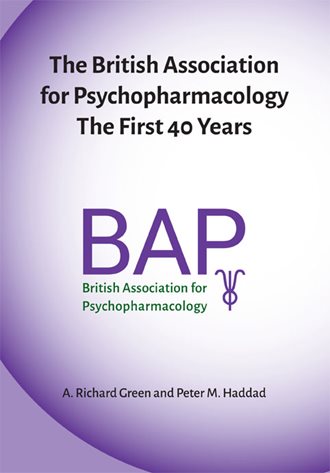It is a question that most people approaching retirement ask themselves: ‘what am I going to do after I retire?’, and it was certainly in my mind as I approached my departure from AstraZeneca in 2007. I had spent my whole career as a research pharmacologist, right from the time I started my PhD studies in 1966. I loved my work in both academia and industry and like many others, pharmacology was my hobby as well as my career. I knew I was lucky in that I had already been appointed Honorary Professor of Neuropharmacology at the University of Nottingham as this position was going to allow me to continue to undertake both research and teaching (it still does). Nevertheless, I wanted more as Nottingham would only fill some of my time. I also had my interest in canals and narrowboats and this duly extended to my being trained and appointed a volunteer lock-keeper on the large mechanical locks on the River Trent - no heaving on gates for me, you just push buttons (Figure 1). However, I also wanted another science-based research interest.

Figure 1 – Richard in his lock-keeping capacity
Shortly before retiring I was asked to write an article on the history of British Pharmacological Society (BPS) meetings when the Society celebrated its 75th birthday. This was followed by a request to contribute a historical review on the neuropharmacology 5-hydroxytryptamine (5-HT, serotonin) for a special issue of the British Journal of Pharmacology as another part of those celebrations. Both requests made me realise I was seen as being of mature years, and that I had undertaken my PhD research on 5-HT in the brain less than 15 years after the neurotransmitter was first identified in this organ. I had met many of the early investigators including Maurice Rapport, who first identified the structure of serotonin in 1948. He had given me letters he had received from John Gaddum thanking him for a small supply of the neurohormone. That supply enabled Gaddum, one of the fathers of British pharmacology, to be the first person to identify 5-HT in the brain. My interest in the history of my area of pharmacology was piqued.
A grant from the BPS Paton Historical Award was obtained and a research project undertaken on the importance of UK scientists in developing our understanding of the pharmacology of 5-HT in the brain. A real find in this investigation was the notebook of Sir John Gaddum (held in the Royal Society library) where he described the effect of self-administering LSD followed by methamphetamine. The results of this historical research were presented to the Society at the 2008 Winter meeting.
I thought this might be the end of my history studies. However, in 2013 another research project arose. The British Association for Psychopharmacology (BAP) was going to be celebrating its 40th birthday in 2014 and I realised that I had been a member since its somewhat controversial foundation; controversial because some wanted it to be limited in membership number and consist primarily of clinical members. I thought that it might be good to write about this controversy since I was involved and remembered it well. Extending the article to cover the subsequent growth of the BAP seemed sensible since many of the founder members were still around to interview. I felt an article in J Psychopharmacol, the journal founded by the BAP, would be appropriate and the editor agreed. I next went to the BAP office to see what records were there and met Peter Haddad who was examining some of the history of psychotherapeutics as recorded in BAP documents. We talked and agreed that a full history of the BAP should be written while it remained a project of reasonable size. The BAP agreed to underwrite the publication cost, and this proved to be rather modest, due mainly to one of the members of the BAP office in Cambridge being an expert in preparing the typescript for self-publication. The printing company involved converted the electronic files into a book in 4 days (Figure 2). I was amazed, remembering that a book of mine published by John Wiley in 1981 took a full year to appear after submission of the typescript.

Figure 2 – The cover of the book celebrating the 40 year history of the British Association for Psychopharmacology
One of the things that struck me in writing this book was just how awful some of the advertised claims made for pharmaceutical products in the 1950s and 1960s were. Awful because of either ignorance about their pharmacology at that time, or hyperbole; I am not suggesting that claims were deliberately fraudulent. This made me wonder about advertising in other therapeutic areas. I felt this would be worth examining and so I approached Jeff Aronson, an old friend and colleague from my days in the MRC Clinical Pharmacology Unit in Oxford. I knew that Jeff was also interested in medical history. He agreed to a partnership and we made a request to the BPS for a grant from the Paton Award. This was given and our research proved very fruitful. I doubt many can claim that a single grant of £750 resulted in three major publications.
We focused on the period 1950-1985 as many modern pharmaceuticals entered the market in this period. Our primary source for material was the British Medical Journal (BMJ), the major UK journal for general practitioners during the 1950s and beyond. We also examined World Medicine magazine that was sent free to all doctors between 1965 and 1984 when it ceased publication. In contrast to BMJ, many adverts in World Medicine, a magazine were in colour. We were lucky that while most academic libraries strip out the advertising pages from journals before binding, all advertising matter in the BMJ had been scanned and was freely available as pdf files online. World Medicine, which had adverts printed throughout the journal, was bound intact in the Bodleian Library, Oxford.
In our first study we examined every other issue of the BMJ (published weekly), totalling around 800 issues, together with 150 issues of World Medicine. We only recorded adverts for specific major therapeutic areas, namely cardiovascular, respiratory and gastrointestinal disorders, and central nervous system disorders (anxiety, sleep, depression, schizophrenia and Parkinson’s Disease).
We found that the peak of advertising was in the 1960s when there was a surge of novel drugs entering the market. Many of these drugs, or their closely related successors are still available today. For example, of the 27 products we recorded as being advertised for CNS disorders between 1960 and 1980, no less than 24 are still available. Unlike today, advertising in that period generally made little or no attempt to educate the reader in terms of providing information on dosing, adverse effects and contraindications. Our qualitative review indicated that the rise of modern therapeutics was mirrored closely in the novel drugs being advertised over this period, and that the adverts must have provided an important source of information to doctors.
In a further investigation we quantified the advertising by counting the adverts for all the major therapeutic areas at defined time points and saw good concordance between the most advertised therapeutic areas and the entry of NCEs to the market. Two observations were particularly noteworthy. One was the rapid decline in the number of companies advertising over time (86 in 1955, 35 in 1975). Many disappeared after regulations required demonstration of quality, safety and efficacy. Also, older off-patent compounds were no longer advertised as modern effective medication became available. So, for example, adverts for antacids for gastric ulcer mostly ceased after the launch of the histamine H2 receptor antagonist cimetidine. The other observation was that the number of adverts also declined precipitously after the mid-1970s, partly due to the strict requirements of the Medicines Act (1968) but also, we suspect, because it became more cost effective to target advertising by using representatives and having a presence at medical meetings, particularly as advertising spend was by now being regulated.
Along with the medical scientific information we also noted that adverts reflected some of the social aspects of the period under review, such as the fact that physicians were invariably men (and if in hospital they had a pretty nurse gazing adoringly at them while they talked to the patient). What was also fascinating was the lack of regulation in place when marketing a new drug. For example, there were several adverts for new compounds baldly stating that this was being made available so that more information could be obtained on its probable efficacy.
Do I have a ‘favourite’ advert? Hard to choose, but the 1972 advert (Figure 3) where it was claimed that Stelazine (trifluoperazine) had value for the patient who ‘needed the true tranquillizing effect and alerting action of Stelazine’ tops the list for a claim being both contradictory and meaningless. I must also add the 1963 advert for Alderlin (pronethanol) since it states it is an ‘adrenergic-receptor antagonist’, surely one of the first times an advert had exposed doctors to the concept of receptors and antagonists.
.jpg.aspx?width=330&height=638)
Figure 3 – A 1972 advert for Stelazine
Young researchers often find it difficult to have time to read about how the area being investigated has arrived at the point they are studying. Electronic literature searching does not help, since the flood of publications tends to suggest that most knowledge is recent. Although history reviews are valuable as they can give an insight into the present, publishing them is problematic, many journals do not want to consider them. We were fortunate that the Society’s journals recognised that such articles have value.
This article is written to encourage pharmacologists, both old and young, to undertake historical research. I hope others may now follow their interests in the history of pharmacology. If enough people were interested, we could perhaps start a BPS Special Interest Group!
Comments
If you are a British Pharmacological Society member, please
sign in to post comments.